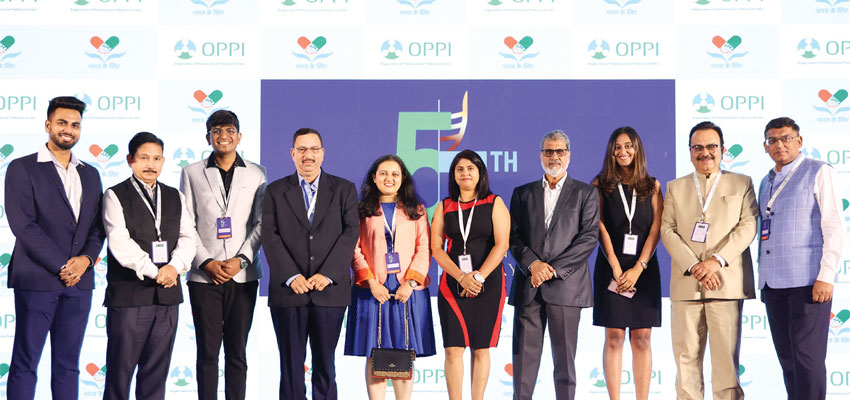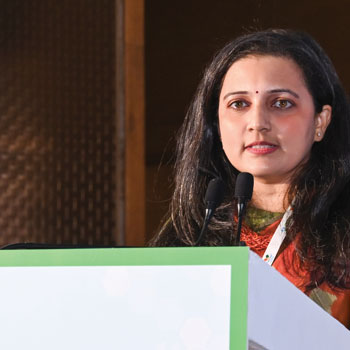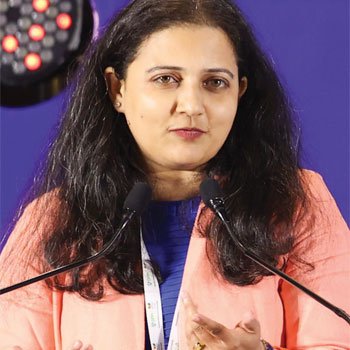Leading patient-centric communication

Post-Covid, entities like the Organisation of Pharmaceutical Producers of India (OPPI) have become increasingly important in transforming healthcare communication, leading ‘Bharat Ke Liye’ campaign, promoting innovative digital strategies, and connecting with healthcare professionals, organisations, and consumers. Leading OPPI’s patient centric communication, is Asawari Sathaye, Director Communications and Patient Advocacy, which has been bridging gaps between various stakeholders in the pharmaceutical industry, for effective, transparent, and accessible healthcare communication in India. She is a proud recipient of the 2024 BW Marketing World 'PR 40Under40' award. She shares insights on her role, the challenges and emerging influences of AI for effective healthcare outcomes
I have been inspired by Sachin Tendulkar’s resilience, power play, sheer talent, mental stability and the way he faced the opposition bowling attack and crack that every time. It used to be amazing to hear “Sachin, Sachin” from the stands every time he would come out to play, his presence lighting up the faces of millions of Indians,” said Asawari Sathaye.
Equipped with a master’s in Economics from University of Mumbai and an MBA in strategy and marketing, from Indian School of Business, her robust educational foundation helped her to transcend various industries and roles. Her background in Economics enabled her to deep-dive into strategic and analytical roles at the Tata Group, while her expertise in strategy and marketing, gained during her MBA days, shaped Asawari’s go-to-market strategies for clients at PwC. It helped her build critical insights into market dynamics, business strategy, communications and investor interactions during her stint at Voltas Limited. Asawari shares her journey, insights and new age AI adaptations, and its impact on the future of the industry.
Corporate Citizen: What qualities enabled your transition from an economist, extending to your current role?
Asawari Sathaye: As I progressed through my career, I embraced opportunities that led me into the field of communications, starting with my role at Voltas Limited. Here, I managed Communications and Investor Relations, collaborating across diverse departments like strategy, finance, and marketing. I led communication strategies for Voltas' expansion into new markets, and built strong relationships with PR media partners and editors through a combination of deep research and industry knowledge. These experiences honed my ability to present complex information in a way that resonated with diverse stakeholders, including investors, ensuring transparency and credibility. Throughout my career, I’ve driven strategic campaigns that amplify brand value, leveraging my diverse background to bring fresh perspectives.
CC: Did your academic background enable your career journey?
The spirit of continuous learning and adaptability became a hallmark of my career, from my work in sustainability projects at Shoppers Stop to my current role at OPPI, where I lead media, communications and patient advocacy. My academic journey has been a crucial enabler in managing and driving government and media advocacy initiatives within key workgroups and committees. Ultimately, my educational background, combined with a strong learning ethos, has been essential in navigating each transition and building a successful career in communications and advocacy.
"The future of communications and patient advocacy in the pharmaceutical industry is poised to become increasingly patient centric, transparent and digitally driven"
-Asawari Sathaye

CC: What are the skills required to strategise good communication tactics?
Strategising effective communication tactics demands a blend of analytical and creative expertise. At the core, understanding the target audience is paramount. This means thoroughly analysing audience demographics, behaviours, and preferences to genuinely resonate tailor messages. Equally important is the ability to deliver clear, concise and consistent messaging across all platforms, reinforcing the brand’s identity and values. A successful communication strategy hinges on goal oriented planning, where objectives—whether it's brand awareness, reputation management, or crisis response—are clearly defined.
CC: How important are media platforms and tools for effective communication?
Choosing the right platforms, from traditional media to digital channels, is vital for maximising reach and impact. Another critical element is timeliness and relevance— staying ahead of industry trends and current events, allows communication experts to adapt their messaging to keep it fresh and impactful. In today's dynamic media landscape, effective communication strategy isn’t just about what’s being said, but also how, when, and where it’s delivered.
CC: What are your primary responsibilities with OPPI India?
My role at OPPI, includes a team of three esources, with support from four agencies. I manage the media interface for the company, including print and traditional media channels as well as the social media handles. OPPI is active on LinkedIn, X and YouTube. I strategise the media and social media content, not only for the brand but also for OPPI leadership; that represents the advocacy of OPPI and highlighting the member companies’ contribution. The OPPI website is another medium to connect with our audience, and also oversee the management and execution across this channel. Internally, I lead various workgroups and committees around ethics, access, supply chain, communications, medical and regulatory, rare diseases, over-the-counter medicines. I am responsible for driving government and media advocacy initiatives within these workgroups and committees.
CC: How do you influence communication strategies with various stakeholders, including regulatory authorities?
I have had the unique opportunity to leverage my position to influence communication strategies with a wide range of stakeholders, including government bodies and regulatory authorities, international and Indian pharmaceutical associations and forums, patient advocacy groups and media. At OPPI, I directly align communication efforts with strategic advocacy goals across critical workgroups and committees, representing the members voice(s) at the regulator and government levels. The position allows me to drive government and media advocacy initiatives through collaborations. It ensures that we meet industry objectives and present clear, fact-based narratives to policy and regulatory decision-makers.
"The regulatory landscape in India can be complex, with constantly evolving policies and guidelines. Ensuring that our communication aligns with these changes while maintaining transparency and credibility for the industry is important"
CC: How do you foster relationships for impactful outcomes?

My strategy has always been to foster strong relationships with key stakeholders by staying transparent and proactive. I have ensured that OPPI’s voice is heard and valued in critical regulatory and policy conversations. I am a member of the Universal Health Coverage (UHC) 2030 Task Force, which comprises of select representatives from various UHC2030 constituencies and beyond. The Action Agenda from the UHC movement is a set of action-oriented policy recommendations that country leaders implement to strengthen resilient and equitable health systems, advance universal health coverage and health security, delivering health for all by 2030. I am also a mentor within the International Federation of Pharmaceutical Manufacturers and Associations (IFPMA) Ethics and Business Integrity Committee's inaugural Africa Mentor Network. The role provides guidance on ethics committee governance, the development and adoption of ethical standards, establishes multi stakeholder partnerships, offering support in communications-related initiatives.
CC: What are some key challenges you face with OPPI India-led advocacy programmes?
I look at challenges more as opportunities to learn and be heard. One such opportunity I have while working on advocacy programmes and industry representation at OPPI India, is balancing the needs and expectations of various stakeholders—government bodies, regulatory authorities, and the industry. The regulatory landscape in India can be complex, with constantly evolving policies and guidelines. Ensuring that our communication aligns with these changes while maintaining transparency and credibility for the industry is important.
CC: What has been your involvement with OPPI’s Bharat Ke Liye campaign?
Under my stewardship, OPPI has launched a strategic initiative Bharat Ke Liye. The endeavour seeks to highlight the contribution of global pharma companies to help meet the ‘unmet’ medical needs of Indian patients; in areas such as pharmaceutical research and development, innovation, access, upholding industry quality standards and ethical practices, manufacturing, supply chain, among others. It was a 360-degree campaign that involved consistent buzz across owned, earned, and paid media platforms. By instilling a sense of national pride, we were able to communicate the pharmaceutical sector's commitment to the well-being of the Indian population. The campaign highlighted the contribution of global research-based pharmaceutical companies in enhancing healthcare in India and addressing unmet medical needs.
CC: Can you cite an example of a successful OPPI India advocacy campaign?
Besides the Bharat Ke Liye initiative, another notable campaign was the "Value of Innovation" social media campaign, which focused on showcasing the contributions of OPPI member companies in making affordable, accessible treatments through continuous innovation. The campaign helped to underscore the importance of research and development, quality standards, and patient care. It strategically educated audiences about the processes involved in creating life-changing medicines, fostering greater appreciation for the pharmaceutical industry’s role in healthcare innovation. Both campaigns were successful in building trust, transparency, and a positive image for the global pharmaceutical industry in India.
CC: How do you collaborate with patient groups and academia?

Fostering collaboration with patient groups and academia on advocacy projects requires a strategic and inclusive approach. At OPPI, we engage with these key stakeholders through knowledge sessions, roundtable and panel discussions. Such inclusive sessions allow us to align on common objectives and tailor our advocacy efforts to meet both patient needs, government goals and industry expectations.
CC: What is the future scope or evolution of communications and patient advocacy?
The future of communications and patient advocacy in the pharmaceutical industry is poised to become increasingly patient-centric, transparent and digitally driven. As patients become more informed and empowered, there is a growing need for clear, accessible communication that demystifies complex medical information, making it understandable for diverse audiences. In the coming years, the industry will likely witness an evolution towards more collaborative models, where pharmaceutical companies, patients, healthcare providers, and advocacy groups will work together to improve healthcare outcomes and ensure that patient needs and preferences are integrated into every step of the healthcare journey.
"AI is a powerful tool that enables us to be more informed and efficient, but the core of our work — building trust, navigating complexities, and fostering relationships, relies on human qualities that AI cannot replace"
CC: What is the significance of AI and social media in your work sphere?
Digital tools, including AI, social media and telehealth platforms, play a significant role in shaping the way pharmaceutical companies engage with patients. These tools enable real time communication, personalised treatment information, and greater accessibility to support. Patient advocacy groups are also likely to gain more influence, to ensure that patient voices are heard in the right forums including healthcare policy mapping.
CC: How impactful is AI in patient advocacy and communication?
AI is increasingly playing a transformative role in communications and PR, particularly in terms of data analysis, automation and content distribution. In my current line of work, AI assists in monitoring industry trends, analysing media coverage, and automating certain repetitive tasks, allowing my team to focus on more strategic and human-centric activities. For instance, we leverage AI for sentiment analysis to gauge public and media perception, which helps shape our advocacy and communication strategies with precision. In essence, AI is a powerful tool that enables us to be more informed and efficient, but the core of our work—building trust, navigating complexities, and fostering relationships—relies on human qualities that AI cannot replace.
CC: How can AI and human empathy strike a balance viz patient advocacy?
I believe that while AI enhances efficiency, there are areas in communications and PR where the human element remains indispensable. Public relations is deeply tied to emotions, trust, and relationship building— factors that AI, despite its capabilities, cannot replicate. Understanding the cultural, social, and emotional nuances when managing crises or creating narratives is a distinctly human skill that goes beyond data-driven insights. For example, empathy and the ability to connect with audiences on a personal level are crucial when working with patient advocacy groups or addressing sensitive healthcare topics. AI can provide frameworks and insights, but the expression of thought, creativity, and subjective rationale behind our communications requires human intuition.
CC: What advice would you give to professionals seeking a career in corporate communications and patient advocacy?
My key advice is to focus on developing a blend of strong communication skills, empathy and strategic insight. In corporate communications, it's crucial to understand the business landscape and tailor messages to resonate with both internal and external stakeholders.
- Emotional intelligence: It plays a pivotal role in both fields, as professionals often need to navigate sensitive issues, manage crises and foster trust. It is important to continuously stay informed about industry trends, as the fields of communications and healthcare are constantly evolving.
- Cultivate relationships: Developing relationships with key stakeholders, including media, government bodies and patient groups, as these connections are essential for effective advocacy and communication efforts. Building trust and adapting to different communication contexts will set a solid foundation for success in these dynamic fields.